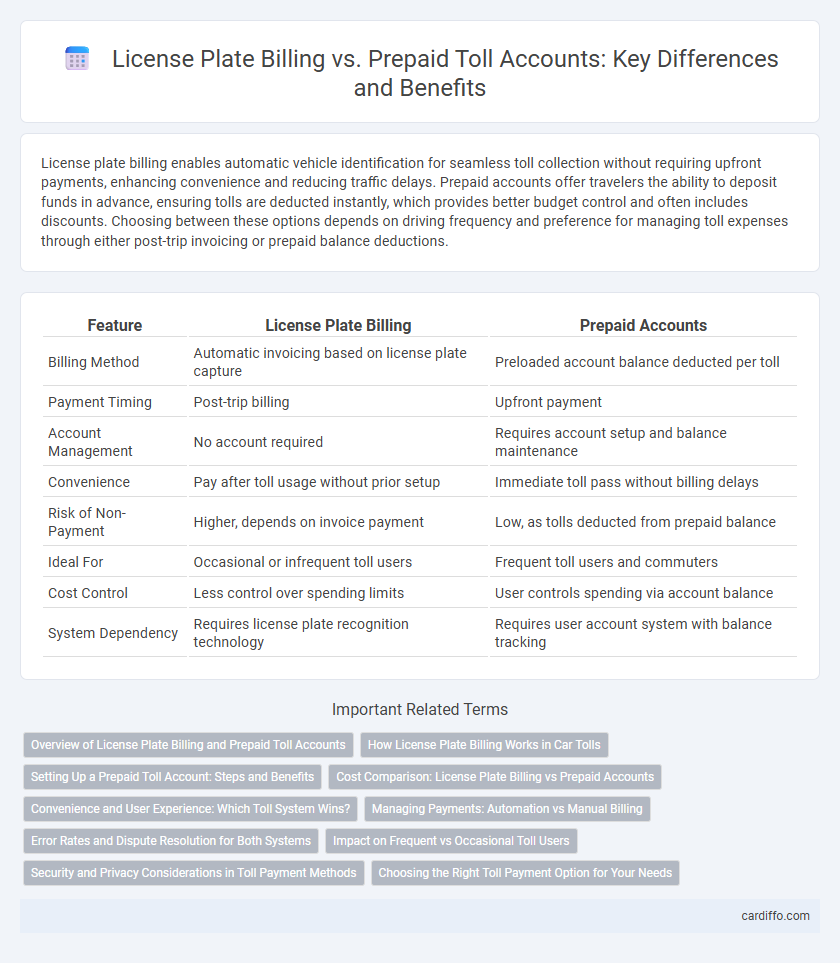License plate billing enables automatic vehicle identification for seamless toll collection without requiring upfront payments, enhancing convenience and reducing traffic delays. Prepaid accounts offer travelers the ability to deposit funds in advance, ensuring tolls are deducted instantly, which provides better budget control and often includes discounts. Choosing between these options depends on driving frequency and preference for managing toll expenses through either post-trip invoicing or prepaid balance deductions.
Table of Comparison
| Feature | License Plate Billing | Prepaid Accounts |
|---|---|---|
| Billing Method | Automatic invoicing based on license plate capture | Preloaded account balance deducted per toll |
| Payment Timing | Post-trip billing | Upfront payment |
| Account Management | No account required | Requires account setup and balance maintenance |
| Convenience | Pay after toll usage without prior setup | Immediate toll pass without billing delays |
| Risk of Non-Payment | Higher, depends on invoice payment | Low, as tolls deducted from prepaid balance |
| Ideal For | Occasional or infrequent toll users | Frequent toll users and commuters |
| Cost Control | Less control over spending limits | User controls spending via account balance |
| System Dependency | Requires license plate recognition technology | Requires user account system with balance tracking |
Overview of License Plate Billing and Prepaid Toll Accounts
License plate billing allows vehicles to be charged for tolls by capturing the license plate image and sending a bill to the registered owner, providing a convenient post-use payment option. Prepaid toll accounts require users to deposit funds in advance, enabling automatic toll deductions and often offering discounted rates for frequent travelers. Both methods streamline toll collection but differ in payment timing and user management, with license plate billing favoring occasional users and prepaid accounts benefiting regular commuters.
How License Plate Billing Works in Car Tolls
License plate billing in car tolls automatically captures the vehicle's license plate using cameras as it passes through a toll point, linking the image to the registered owner's account for payment processing. This system eliminates the need for in-car transponders by generating an electronic invoice based on the license plate information, which is sent to the vehicle owner for payment. The efficiency of license plate billing relies on accurate optical character recognition (OCR) technology and up-to-date vehicle registration databases to ensure timely and correct toll charges.
Setting Up a Prepaid Toll Account: Steps and Benefits
Setting up a prepaid toll account simplifies travel by allowing drivers to load funds in advance for automatic toll payments, reducing delays at toll plazas. Key steps include registering online, linking license plate information or transponder details, and selecting a funding method such as credit card or bank transfer. Benefits include discounted toll rates, convenient account management, real-time balance updates, and elimination of late payment fees associated with license plate billing.
Cost Comparison: License Plate Billing vs Prepaid Accounts
License plate billing often incurs higher costs due to per-transaction fees and delayed payments, resulting in potential administrative expenses and penalties. Prepaid accounts offer cost savings through discounted toll rates and eliminated invoice processing fees, providing better budget control and simplified account management for frequent users. Businesses and regular commuters can reduce overall toll expenses by leveraging prepaid accounts rather than relying on license plate billing methods.
Convenience and User Experience: Which Toll System Wins?
License plate billing offers seamless convenience by eliminating the need for physical transponders, allowing drivers to pass through tolls without stopping or managing accounts. Prepaid accounts provide users with predictable expenses and easy balance monitoring through apps, enhancing control over toll spending. User experience depends on preferences for hassle-free travel versus proactive payment management, with license plate billing favored for simplicity and prepaid accounts valued for financial oversight.
Managing Payments: Automation vs Manual Billing
License plate billing automates toll payments by capturing vehicle information through cameras, reducing manual intervention and minimizing human errors. Prepaid accounts require upfront funding but streamline toll usage with automatic deductions, offering convenience and real-time balance updates. Automated systems enhance payment accuracy and efficiency, while manual billing may increase administrative workload and delay payment processing.
Error Rates and Dispute Resolution for Both Systems
License plate billing systems have higher error rates due to image recognition inaccuracies, resulting in frequent disputes requiring extensive manual reviews, which delays resolution and increases administrative costs. Prepaid accounts reduce errors by linking vehicle data directly to the account, enabling real-time validation and streamlined dispute resolution through instant transaction records. Statistical analyses show prepaid account systems decrease error-related disputes by up to 70%, improving overall efficiency and user satisfaction in toll management.
Impact on Frequent vs Occasional Toll Users
License plate billing simplifies toll access for occasional users by eliminating the need for prepaid accounts, reducing upfront costs but resulting in higher per-use fees. Frequent toll users benefit more from prepaid accounts, which offer discounted rates and streamlined billing, enhancing cost efficiency and payment convenience. The choice between these systems directly impacts user expenses and convenience based on toll usage frequency.
Security and Privacy Considerations in Toll Payment Methods
License plate billing systems increase convenience but raise concerns about data security and user privacy due to the transmission and storage of vehicle information. Prepaid accounts offer enhanced privacy protections by limiting data collection to account holders and employing encrypted transactions to safeguard personal and financial details. Secure toll payment methods prioritize minimizing unauthorized access and ensuring compliance with data protection regulations to protect users from identity theft and surveillance risks.
Choosing the Right Toll Payment Option for Your Needs
Selecting the right toll payment option depends on your travel frequency and convenience preferences. License plate billing allows occasional travelers to pay tolls based on vehicle registration without requiring a physical transponder, often resulting in higher per-use fees. Prepaid accounts offer frequent commuters discounted rates and automatic toll deduction, making them cost-effective and efficient for regular toll road users.
License plate billing vs prepaid accounts Infographic

 cardiffo.com
cardiffo.com